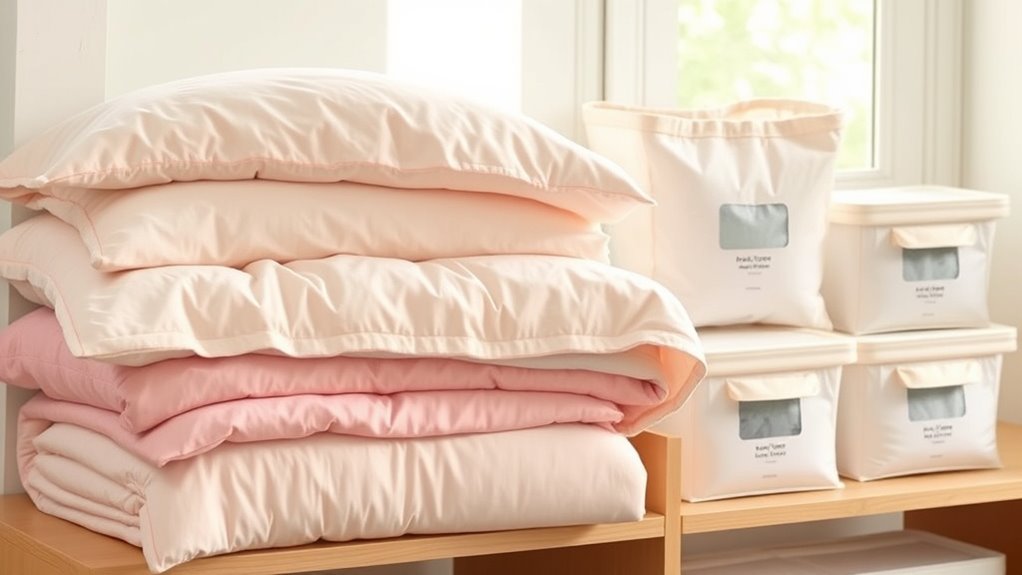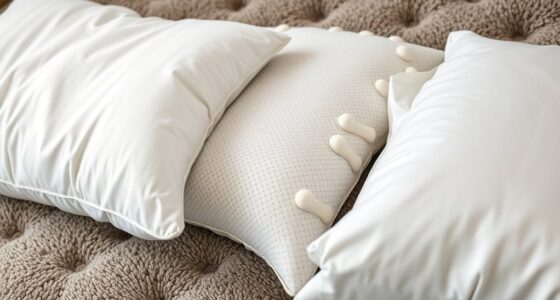To store bedding properly, choose breathable containers like cotton or linen bags and avoid plastic, which traps moisture. Keep your items in a cool, dry place away from sunlight, and make certain they’re thoroughly clean and dry before storage. Fold or roll bedding neatly, label containers for easy identification, and leave space for air circulation. Regularly check for pests or dampness to keep your bedding fresh and ready. Continue to explore tips for ideal storage.
Key Takeaways
- Use breathable storage bags like cotton or linen to prevent moisture and mold growth.
- Store bedding in a cool, dry place away from direct sunlight for longevity.
- Fold or roll bedding neatly and label containers with contents and season for easy access.
- Keep stored bedding in stackable, airtight containers with a small gap for air circulation.
- Regularly check stored bedding for pests, dampness, and freshness to maintain quality.

Storing bedding properly is essential to keep it fresh, clean, and in good condition for future use. The way you choose storage containers plays a significant role in maintaining the quality of your bedding. Opt for breathable options like cotton or linen storage bags, which prevent moisture buildup and mold growth. Avoid plastic bags that trap humidity, as they can cause your bedding to develop a musty smell or mildew. Clear containers are helpful because they allow you to see your items without opening them, making it easier to locate what you need later. When selecting storage solutions, consider stackable bins with secure lids for efficient use of space and added protection against dust and pests.
Implementing a seasonal bedding rotation system can also prolong the lifespan of your bedding and keep your linen collection fresh. During warmer months, store heavier blankets, comforters, and flannel sheets to free up space and prevent them from becoming overly warm or damp. Conversely, in winter, rotate in lightweight sheets and summer bedding that are better suited for the season. This approach not only helps you stay organized but also reduces clutter in your storage area. When doing a seasonal rotation, ensure your bedding is clean and completely dry before storing it away. Folding or rolling your bedding neatly prevents wrinkles and makes stacking easier, which is especially helpful when space is limited. Label your storage containers clearly with the contents and the season, so you can quickly identify what you need without rummaging through multiple bins. Additionally, using self-watering plant pots as a storage solution can help maintain a dry environment and prevent moisture issues.
It’s important to keep your stored bedding in a cool, dry place away from direct sunlight, which can cause fading and deterioration over time. Consider storing in a closet, under the bed, or in a dedicated linen chest where temperature and humidity levels stay stable. If you’re using larger storage bins, leave a small gap for air circulation to prevent moisture buildup. Regularly check your stored bedding for any signs of pests or dampness, especially if you’re storing it for extended periods. Reassessing your storage setup periodically helps catch any issues early, ensuring your bedding remains fresh and ready to use when needed. By choosing the right storage containers and establishing a seasonal bedding rotation routine, you keep your linens in excellent condition, making future laundry days easier and your bedding more inviting whenever you need it.
Frequently Asked Questions
How Often Should Bedding Be Cleaned Before Storage?
You should clean your bedding before storage at least once every two weeks to prevent dust mites and maintain fabric softness. Regular washing removes dirt, sweat, and allergens, ensuring your bedding stays fresh and hygienic. If you’re storing bedding for an extended period, wash it thoroughly to eliminate dust mites and other potential irritants. This way, your bedding remains clean, soft, and ready for use whenever you need it.
Can Vacuum-Sealed Bags Damage Delicate Bedding Fabrics?
Did you know that improper storage can damage up to 30% of delicate fabrics annually? When using vacuum-sealed bags, you risk vacuum sealer risks like crushing or deforming delicate fabrics. These bags can cause fibers to weaken or tear over time, especially if the bedding is fragile. To protect your bedding, avoid vacuum-sealing delicate fabrics or use gentle, breathable storage options instead.
What’s the Best Way to Prevent Mold in Storage Containers?
To prevent mold in storage containers, focus on moisture control and container ventilation. You should guarantee your containers are airtight but also allow airflow to prevent excess humidity build-up. Using silica gel packs helps absorb moisture, while leaving small vents or using breathable storage bins promotes proper air circulation. Regularly check your stored bedding for signs of dampness or mold, and keep the storage area cool and dry to protect your bedding.
How Do I Organize Bedding for Easy Access Later?
To organize your bedding for easy access later, start by folding everything neatly and grouping similar items together. Use decorative storage bins or baskets to keep your bedding tidy and visually appealing. Incorporate seasonal rotation by storing off-season bedding separately, making it easier to find what you need. Label the containers clearly, so you quickly grab the right set without rummaging through your storage.
Are There Eco-Friendly Storage Options for Bedding?
Did you know that over 300 million tons of plastic waste are produced globally each year? You can choose eco-friendly storage options for your bedding by using organic alternatives like cotton or hemp baskets, which are biodegradable and sustainable. These containers not only protect your bedding but also help reduce plastic waste. By opting for biodegradable containers, you make a positive impact on the environment while keeping your bedding organized and accessible.
Conclusion
Storing your bedding properly keeps it fresh and extends its lifespan. Remember, clean and dry bedding stored in a breathable container can last up to a year without losing quality. Did you know that about 80% of dust mites live in bedding? Keeping your bedding well-ventilated and properly stored helps reduce allergens and ensures a healthier sleep environment. So, take the time to store your bedding correctly—you’ll sleep better knowing it’s clean and ready when you need it.








